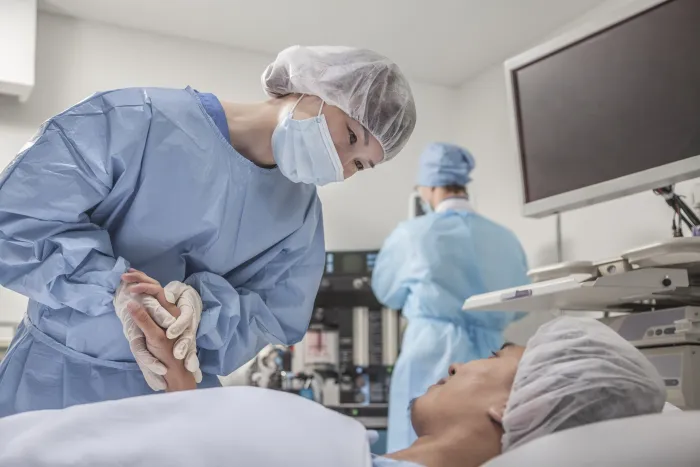General Orthopaedic Surgical Procedures

At Resurgens, our highly trained general orthopaedists help diagnose, prevent, and treat injuries to your bones, joints, muscles, nerves, tendons, and ligaments. Our treatment plans can often include both non-surgical and surgical treatment solutions. Typically, surgical interventions are only recommended after all conservative options have been exhausted.
Before undergoing any orthopaedic procedure, we guide patients through appropriate imaging tests and other diagnostic exams that help us accurately assess the injury or condition. This process ensures that we deliver effective treatment plans that meet each patient's specific needs.
Because the human body can sustain many types of injuries, there are a variety of surgical solutions for treatment. These run the gamut from minimally-invasive treatments like arthroscopy and endoscopy to more assertive treatment plans like open-incision surgery. Our expert physicians specialize in performing advanced surgical procedures for the following areas:
Common Orthopaedic Procedures
At Resurgens, it's our goal to keep you as comfortable as possible during your treatment. We also intend to provide you with the most direct path to recovery for your specific condition. Many times, that means a procedure may include some anesthesia, injections, or grafting. Below, we have included additional explanations for some common procedures that may be a part of your treatment plan. To learn more, click on a specific procedure's link to view an educational video.
Amniotic and Placental Graft Tissue for Surgery and Wound Care
Amniotic and Placental Graft Tissue for Surgery and Wound Care: These grafts are made from recovered fetal tissue, which is harvested after birth. Components include the placenta, umbilical cord, or tissues of the amniotic membrane. When this graft is introduced into your body or onto your skin, it surrounds and protects your damaged tissues. It can provide a scaffold for your body as it repairs cells. This procedure is associated with reduced inflammation and scarring as well as adhesion prevention.
Anesthesia (Overview)
Anesthesia (Overview): There are many types of anesthetics used to block the pain of a medical procedure. Local anesthesia is used for minor procedures such as sutures or skin biopsies. Local anesthesia is used to numb a small area of tissue without affecting the surrounding areas. Regional anesthesia is used for more extensive procedures that involve larger areas of the body, such as the knee or hand. They can block sensation in an entire limb. Conscious sedation is a form of anesthesia that relaxes the patient and dulls painful sensations. It is used during procedures like endoscopy and plastic surgery. General anesthesia results in a complete loss of consciousness. It is commonly used for major surgery.
General Anesthesia
General Anesthesia: There are two main types of general anesthesia. Intravenous anesthesia is given through a needle, and gas anesthesia is supplied through a mask or a tube. The type that is used will depend on the procedure. An anesthesia provider also examines a patient's medical history and past use of anesthesia to decide which type is best for the patient.
Local Anesthesia
Local Anesthesia: Before administering local anesthesia, a health care professional considers the patient's health, medications, allergies, and past use of anesthesia in order to decide which solution is best for the patient. Local anesthesia can be injected with a needle or administered with a cream or gel. The type used depends on the part of the body it is used on.
Monitored Anesthesia Care (MAC)
Monitored Anesthesia Care (MAC): Anesthesia may sometimes be given to the patient through a needle or an IV. The amount depends on the medical procedure. Some patients feel relaxed and groggy but are awake during the entire procedure and can respond to questions and commands. Others may fall into a light sleep. The anesthesia provider monitors the patient's vital signs and adjusts the anesthesia to keep the patient safe and comfortable. The patient will not remember the pain from the procedure.
Multimodal Anesthesia and Pain Control
Multimodal Anesthesia and Pain Control: With this approach, patients are given focused anesthesia and a combination of pain medicines. The types and doses and these medicines may differ according to your needs. Your multimodal plan may begin before your procedure. This approach speeds your discharge from the hospital, eases your transition to physical therapy, and can even shorten the overall length of your recovery.
Peripheral Nerve Block Anesthesia
Peripheral Nerve Block Anesthesia is injected with a needle. The site of the injection depends on the part of the body being treated. The needle is placed near a cluster of nerves that serve as a pathway for pain signals. The medicine blocks sensation along these nerves. Effects of Peripheral Nerve Block can last several hours after the procedure.
Regional Anesthesia
Regional Anesthesia can be injected in the area around one or more nerves in the arms or legs to numb all or parts of these extremities. In some cases, a catheter is inserted to numb a limb, torso, or groin area for a long period of time. It is commonly used with general anesthesia.
Tendon Repair (Augmentation with Collagen Graft)
Tendon Repair (Augmentation with Collagen Graft): The tendon is prepared and damaged parts of the tendon are trimmed away. The tendon may be strengthened with sutures or other techniques. Once this is complete, the surgeon adds the graft tissue. The tissue can be wrapped around the tendon or layered on one side of the tendon. The graft material is sutured into place, and it will be absorbed by the tendon as it heals.
Non-Surgical Orthopaedic Procedures
Your musculoskeletal system is a complex array of interwoven muscles, tendons, bones, and skin. Depending on the type of injury - and the extent of your damage - you may not require surgery.
At Resurgens, we attempt to exhaust all conservative, non-surgical solutions before considering more serious measures. Non-surgical solutions may include procedures like physical therapy, stem cell therapy, or other injectables. These treatments can help the body promote internal healing.
Schedule an appointment with Resurgens today to learn more about your condition and available treatment plans.